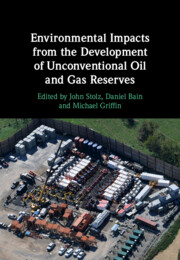Book contents
- Environmental Impacts from the Development of Unconventional Oil and Gas Reserves
- Environmental Impacts from the Development of Unconventional Oil and Gas Reserves
- Copyright page
- Contents
- Figures
- Tables
- Contributors
- Preface
- Part I Overview
- Part II Environmental Analysis
- 5 Air Quality
- 6 Methane and Climate Change
- 7 Water Usage and Management
- 8 Seismicity Induced by the Development of Unconventional Oil and Gas Resources
- 9 Naturally Occurring Radioactive Material (NORM)
- 10 Metal Isotope Signatures as Tracers for Unconventional Oil and Gas Fluids
- 11 Isotopes as Tracers of Atmospheric and Groundwater Methane Sources
- 12 The Microbiology of Shale Gas Extraction
- Part III Case Studies
- Index
- References
11 - Isotopes as Tracers of Atmospheric and Groundwater Methane Sources
from Part II - Environmental Analysis
Published online by Cambridge University Press: 28 July 2022
- Environmental Impacts from the Development of Unconventional Oil and Gas Reserves
- Environmental Impacts from the Development of Unconventional Oil and Gas Reserves
- Copyright page
- Contents
- Figures
- Tables
- Contributors
- Preface
- Part I Overview
- Part II Environmental Analysis
- 5 Air Quality
- 6 Methane and Climate Change
- 7 Water Usage and Management
- 8 Seismicity Induced by the Development of Unconventional Oil and Gas Resources
- 9 Naturally Occurring Radioactive Material (NORM)
- 10 Metal Isotope Signatures as Tracers for Unconventional Oil and Gas Fluids
- 11 Isotopes as Tracers of Atmospheric and Groundwater Methane Sources
- 12 The Microbiology of Shale Gas Extraction
- Part III Case Studies
- Index
- References
Summary
Methane is a potent greenhouse gas and can create explosion risk at elevated concentrations. Because there are several major anthropogenic sources of methane and other natural sources of methane that are elevated due to climate feedbacks, there is currently no scientific consensus on the cause of increasing global atmospheric methane concentrations. Methane dissolved in groundwater can also have multiple sources that are difficult to distinguish. Luckily, methane has several naturally occurring stable and radioactive isotopes that can help to differentiate these sources. In this chapter I will present an overview of the isotopic composition of various methane sources, including stable and radioactive isotopes of both carbon and hydrogen; give examples of using isotopes to decipher atmospheric methane sources at the local, regional, and global level; and then give examples of using isotopes to distinguish between major sources of methane in groundwater. All of these examples will include natural gas sources, since that is the theme of this book, although isotope tools can be applied to many other types of methane sources.
- Type
- Chapter
- Information
- Publisher: Cambridge University PressPrint publication year: 2022



